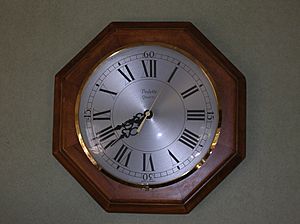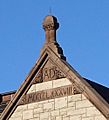Roman numerals facts for kids

Roman numerals are a special way of writing numbers that was first used by the Ancient Romans. Instead of using digits like 1, 2, 3, they use letters from the Latin alphabet. Today, we still see Roman numerals in many places!
There are seven main symbols used in Roman numerals:
| Symbol | I | V | X | L | C | D | M |
|---|---|---|---|---|---|---|---|
| Value | 1 | 5 | 10 | 50 | 100 | 500 | 1,000 |
Even after the powerful Roman Empire ended, people in Europe kept using Roman numerals for a long time. Around the 14th century, they slowly started using Arabic numerals (the numbers we use today: 1, 2, 3, etc.) instead. But Roman numerals are still used for certain things even now!
For example, you might see them on clock faces. On the famous Big Ben clock in London, the hours from 1 to 12 are written like this:
I, II, III, IV, V, VI, VII, VIII, IX, X, XI, XII
Notice that 4 is written as IV and 9 as IX. This is a special rule we'll learn about soon. However, on many Roman numeral clocks, you might see 4 written as IIII instead of IV.
Contents
How to Write Roman Numerals
The Subtraction Rule
There's a clever rule that makes Roman numerals shorter. If you have the same symbol written four times, you can often replace it by putting a smaller number symbol before a larger one. This means you subtract the smaller number from the larger one.
- For example, instead of IIII (1+1+1+1 = 4), you write IV (5-1 = 4).
- Instead of XXXX (10+10+10+10 = 40), you write XL (50-10 = 40).
This rule has been used since the Middle Ages. Usually, only one smaller number is subtracted. So, 18 is usually XVIII (10+5+1+1+1), not IIXX. Also, the subtraction rule only works for symbols that are right next to each other in the number sequence. For example, 99 is written XCIX (100-10 + 10-1), not IC.
Writing Years with Roman Numerals
It's quite simple to write a year using Roman numerals. You just need to break down the number into its largest possible Roman numeral parts.
Let's take the year 1984 as an example. If we don't use the subtraction rule, it would look like this:
| 1 × 1000 | + | 1 × 500 | + | 4 × 100 | + | 1 × 50 | + | 3 × 10 | + | 4 × 1 | = | 1984 |
| M | + | D | + | CCCC | + | L | + | XXX | + | IIII | = | MDCCCCLXXXIIII |
To read a Roman numeral, you simply add up the values of its symbols.
Now, let's write 1984 using the subtraction rule, which is more common today:
| 1 × 1000 | + | (−1 × 100 + 1 × 1000) | + | 1 × 50 | + | 3 × 10 | + | (−1 × 1 + 1 × 5) | = | 1984 |
| M | + | CM | + | L | + | XXX | + | IV | = | MCMLXXXIV |
Special Values in Roman Numerals
Zero
The number zero doesn't have its own Roman numeral symbol. Around the year 725, a scholar named Bede (or someone working with him) used the letter N to mean zero. This letter came from the Latin word nihil, which means "nothing."
Fractions
The Romans also had ways to write fractions. The most common fraction they used was 1/12. In Latin, this was called uncia, which is where our word "ounce" comes from. The symbol for 1/12 was a single dot (·). Half (1/2) was shown with an S.
Large Numbers
For very large numbers, the Romans developed a few different systems. One simple way was called the vinculum system. In this system, if you put a line (called an overline) over a Roman numeral, it meant you multiplied its value by 1,000.
For example:
| Numeral | V | X | L | C | D | M |
|---|---|---|---|---|---|---|
| Value | 5,000 | 10,000 | 50,000 | 100,000 | 500,000 | 1,000,000 |
Where We See Roman Numerals Today
- In some countries like the Baltics and Russia, the days of the week are sometimes written with Roman numerals. I often means Monday.
- When people write dates by hand, especially in the day-month-year order, the month might be a Roman numeral. For example, 26.XI.2014 means November 26, 2014.
- The year a movie or book was made or copyrighted is often shown in Roman numerals.
- When talking about Monarchs (like kings and queens) or Popes, Roman numerals are used to count them. For example, Queen Elizabeth II means Queen Elizabeth the Second.
- In France, the school terms (trimesters) are sometimes counted with Roman numerals.
- In Poland, Roman numerals are used for months in dates and as a quick way to write ordinal numbers (like 6th as VI).
- Even computers use Roman numerals! There's a special code block in Unicode (a system for text on computers) that includes Roman numeral symbols.
Related pages
Images for kids
-
Roman numerals on the back of the ship Cutty Sark. They show how deep the ship sits in the water, from 13 to 22 feet.
-
The year 1910 on Admiralty Arch in London, written as MDCCCCX. This is an older way of writing it, instead of the more common MCMX.
-
A padlock from the gate of the Irish town of Athlone. The year 1613 is written as XVIXIII, which is unusual.
-
The year 1888, when the Cambridge Public Library was built, shown in standard Roman numerals on its front.
-
Boris Yeltsin's signature, dated November 10, 1988, written as 10.XI.1988.
-
A sign on a shop window in Vilnius, Lithuania, showing business hours using Roman numerals.
See also
 In Spanish: Numeración romana para niños
In Spanish: Numeración romana para niños


















